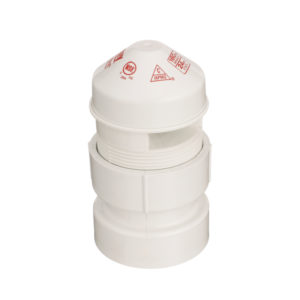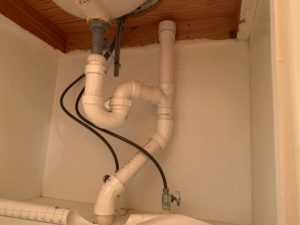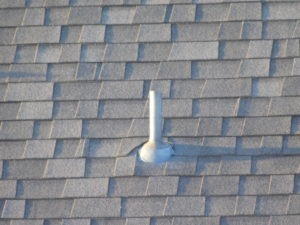 An Air Admittance Valve (AAV) is a one-way vent that is normally closed but opens to allow air to be drawn in when there is a negative pressure (a suction or vacuum) in the drain line. The Air Admittance Valve remains closed at all other times to prevent air or sewer gases from flowing out of the vent pipe and into the home. AAVs eliminate the need for passive vents (the vent pipes or vent stacks that normally stick out through roofs).
An Air Admittance Valve (AAV) is a one-way vent that is normally closed but opens to allow air to be drawn in when there is a negative pressure (a suction or vacuum) in the drain line. The Air Admittance Valve remains closed at all other times to prevent air or sewer gases from flowing out of the vent pipe and into the home. AAVs eliminate the need for passive vents (the vent pipes or vent stacks that normally stick out through roofs).
Air Admittance Valves are also called Studor vents, and these two terms will be used interchangeably in this post. The term Studor vent is used because Studor was the company that originally invented them. Today, however, there are several companies that produce these vents, but the name stuck and the two terms, AAV and Studor vent, are often used interchangeably.
 When a plumbing fixture (toilet, sink, tub, etc) drains, air must be drawn into the pipe behind the draining water in order to replace the water – otherwise negative pressure or a vacuum will develop in the pipe which will prevent the water from flowing properly down the pipe. An example of this is a straw that you pull out of a glass of water while holding your finger over the top of the straw. When you do this, the water cannot flow out of the straw because air cannot be drawn in behind the water.
When a plumbing fixture (toilet, sink, tub, etc) drains, air must be drawn into the pipe behind the draining water in order to replace the water – otherwise negative pressure or a vacuum will develop in the pipe which will prevent the water from flowing properly down the pipe. An example of this is a straw that you pull out of a glass of water while holding your finger over the top of the straw. When you do this, the water cannot flow out of the straw because air cannot be drawn in behind the water.
The same phenomenon can occur when a sink or tub is draining if the drain system is not properly vented. Without proper venting the water will not drain properly. It can gurgle, and it can even suck the water out of the trap that must be kept full of water so it can prevent sewer gases from entering the home. This is why vents must be installed on all drain systems. (See my post about plumbing vents.)
A Studor vent, or air admittance valve, is normally used when it is impractical to run a vent pipe inside a wall, through the attic, and out through the roof.
 A good example of when an AAV is used would be on the drain line of a sink on a kitchen island since there is no wall in which a vent pipe can be run up to the attic. Another use may be when there is a need to run a vent pipe that would otherwise end up coming out through the roof on the front side of the home. Vent pipes visible from the front side of the home are not desirable as they do not look good aesthetically.
A good example of when an AAV is used would be on the drain line of a sink on a kitchen island since there is no wall in which a vent pipe can be run up to the attic. Another use may be when there is a need to run a vent pipe that would otherwise end up coming out through the roof on the front side of the home. Vent pipes visible from the front side of the home are not desirable as they do not look good aesthetically.
Plumbing vents serve two purposes:
- They allow air to be drawn in behind draining water as described above, and
- They allow pressure that develops in the drain system to be relieved by being vented out through the vent system.
Air admissive valves can accomplish purpose #1 mentioned above, but since they are one-way valves, they do not allow pressure to be vented out of the drain system. Because of this limitation of AAVs, all homes are required to have at least one regular plumbing vent installed. In other words, a home cannot have only air admittance valves – they must also have at least one regular plumbing vent to help relieve any pressure that builds up in the drain system. Code states “Within each plumbing system, not less than one stack vent or vent stack shall extend outdoors to the open air.” (rule 918.7 of the Universal Plumbing Code)
Are Air Admissive Valves Allowed by Code?
Air admissive valves are allowed to be installed in some states, but not in other states. It is highly recommended that you check with your AHJ (Authority Having Jurisdiction) prior to installing an AAV in your home.
Installation Requirements for Studor Vents
Installation requirements for Studor vents vary depending on what code has been adopted by the particular state or jurisdiction. Here are some general requirements that apply to the installation of most AAV’s.
- AAVs serving just one fixture should be at least 4″ higher than the center of the trap arm.
- When an air admittance valve serves multiple fixtures, it should be at least 6″ above the flood level rim of the highest fixture that it serves. Any AAV should only vent fixtures that are on the same floor level of the home.
- Since they rely on gravity to close, air admittance valves must be installed vertically. (A maximum of 15 degrees from vertical is allowed.)
- When AAV’s are installed in attics, they should be installed at least 6 inches above the insulation in order to prevent insulation from being sucked into the valve. (Insulation in the valve can prevent it from properly sealing.)
- Air admissive valves must be installed within a ventilated space that allows air to freely enter the valve, and where they are accessible.
- As stated earlier, there must be at least one regular passive plumbing vent installed on the home.
Pros and Cons of Air Admittance Valves
Pros:
- Money – AAVs can reduce the amount of materials and time needed to plumb a home. This can make it less costly to plumb the home.
- Flexibility – The ability to use AAV’s can give much greater flexibility in the layout of the plumbing system since walls, windows, and the location within the home (such as on a front wall) are non issues if AAV’s are being used.
- Roof maintenance – With fewer roof penetrations, roof maintenance will be simpler. The opportunity for roof leaks will also be decreased.
Cons:
- Less effective – They do not work as well as standard, passive plumbing vents (the pipes going up through your roof) because they only serve one of the two purposes of the passive vent.

- Fail – Since they have moving parts, air admissive valves are prone to eventually fail. A simple open pipe through the roof has no moving parts and can last virtually forever.
- Cannot be used everywhere – They are not allowed to be used in all jurisdictions, so they may not be an option for you.
Summary
Air admissive valves have some benefits and are very useful in certain applications in the plumbing systems of many homes, but they also have limitations that prevent them from being used in other applications. They certainly are not simply allowed to be used as a one-for-one substitute for the passive plumbing vents that penetrate the roofs on most homes. In my opinion, these Studor vents should only be used as a last resort when the passive vent pipes cannot be used for one reason or another.
In my opinion, these Studor vents should only be used as a last resort when the passive vent pipes cannot be used for one reason or another.
© 2020 Mike Morgan
This article was written by Mike Morgan, the owner of Morgan Inspection Services. Morgan Inspection Services has been providing home, septic and well inspection services throughout the central Texas area since 2002. He can be reached at 325-998-4663 or at mike@morganinspectionservices.com. No article, or portion thereof, may be reproduced or copied without prior written consent of Mike Morgan.

